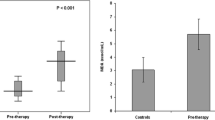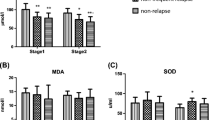Abstract
The production of free radicals can cause renal injury and play a role in the pathogenesis of acute renal failure (ARF). The indirect markers of reactive oxygen species (ROS) were evaluated in children with ARF and controls. Forty patients with ARF aged 0–10 years were selected. Twenty age- and gender-matched healthy children were included as controls. Plasma malondialdehyde, protein carbonyl, nitrite, copper, ascorbic acid, zinc, and ceruloplasmin levels were estimated in patients with ARF and controls. The plasma malondialdehyde (p < 0.01), copper (p < 0.001), ascorbic acid (p < 0.05), and ceruloplasmin (p < 0.001) levels were significantly raised in ARF patients in comparison with controls. Significantly higher levels of plasma malondialdehyde (p < 0.01), nitrite (p < 0.001), copper (p < 0.001), and ceruloplasmin (p < 0.001) and lower plasma zinc (p < 0.01) were found in ARF nonsurvivors in comparison with survivors. The cutoff levels of plasma nitrite and ceruloplasmin were found to be most accurate in predicting mortality in ARF patients and had maximum sensitivity (100%) and specificity (60.7%) among the parameters studied. In conclusion, the increased levels of oxidants and antioxidants suggest the production of ROS and their possible role in ARF pathogenesis. Plasma nitrite and ceruloplasmin concentrations demonstrated predictive ability in relation to mortality.
Similar content being viewed by others
Abbreviations
- ARF:
-
acute renal failure
- MDA:
-
malondialdehyde
- ROS:
-
reactive oxygen species
References
Brady HR, Singer GG (1995) Acute renal failure. Lancet 346:1533–1540
Bhuyan UN, Bagga A (1991) Thrombo-occlusive nephroangiopathy in children with acute renal failure and hypertension. Indian J Nephrol 1:137–138
Baud L, Ardaillou R (1993) Involvement of reactive oxygen species in kidney damage. Brit Med Bull 49:621–629
Cheesman KH, Slatter TF (1993) An introduction to free radical biochemistry. Brit Med Bull 49:481–493
Greene AL, Paller MS (1991) Oxygen free radicals in acute renal failure. Miner Electrolyte Metab 17:124–132
Dubey NK, Yadav P, Dutta AK, Kumar V, Ray GN, Batra S (2000) Free oxygen radicals in acute renal failure. Indian Pediatr 37:153–158
Nath KA, Norby SM (2000) Reactive oxygen species and acute renal failure. Am J Med 109:665–678
Paller MS, Hoidal JR, Ferris TF (1984) Oxygen free radicals in ischemic acute renal failure in the rat. J Clin Invest 74:1156–1164
Satoh K (1978) Serum lipid peroxide in cerebrovascular disorders determined by a new colorimetric method. Clin Chem Acta 90:37–43
Reznick AZ, Packer L (1994) Oxidative damage to proteins: spectrophotometric method for carbonyl assay. Methods Enzymol 233:357–363
Moshage H, Kok B, Huizenga JR, Jansen PLM (1995) Nitrite and nitrate determinations in plasma: a critical evaluation. Clin Chem 41:892–896
Roe JH (1954) Chemical determination of ascorbic, dehydroascorbic and diketogulonic acids. Methods Biochem Anal 1:137–140
Ravin HA (1961) An improved colorimetric enzymatic assay of ceruloplasmin. J Lab Clin Med 58:161–168
Li Y, Trush MA (1993) Oxidation of hydroquinone by copper chemical mechanism and biological effects. Arch Biochem Biophys 300:346–355
Milne L, Nicotera P, Orrenius S, Burkitt MJ (1993) Effects of glutathione and chelating agents on copper-mediated DNA oxidation: pro-oxidant and antioxidant properties of glutathione. Arch Biochem Biophys 304:102–109
Nanda R, Mishra PK, Das UK, Rout SB, Mohapatra PC, Panda A (2004) Evaluating role of oxidative stressing determining the pathogenesis of falciparum malaria induced acute renal failure. Indian J Clin Biochem 19:93–96
Sharma AK, Arora M, Gupta R, Makkad RK, Gupta HP (1998) Free radicals in acute renal failure due to falciparum malaria. Indian J Nephrol 8:101–103
Scheibmeir HD, Christensen K, Whitaker SH, Jegaethesan J, Clancy R, Pierce JD (2005) A review of free radicals and antioxidants for critical care nurses. Intensive Crit Care Nurs 21:24–28
Zwolińska D, Grzeszczak W, Kiliś-Pstrusińska K, Szprynger K, Szczepańska M (2004) Lipid peroxidation and antioxidant enzymes in children with chronic renal failure. Pediatr Nephrol 19:825–948
Zwołińska D, Grzeszczak W, Szczepańska M, Kiliś-Pstrusińska K, Szprynger K (2006) Lipid peroxidation and antioxidant enzymes in children on maintenance dialysis. Pediatr Nephrol 21:705–710
Halliwell B, Gutteridge JMC (1999) Free radicals, other reactive species, and disease. In: Halliwell B, Gutteridge JMC (eds) Free radicals in biology and medicine. 3rd edn. Oxford University Press, Oxford, pp 617–783
Du XH, Yang CL (1994) Mechanism of gentamicin nephrotoxicity in rats and the protective effect of zinc-induced metallothionein synthesis. Nephrol Dial Transplant 9(Suppl 4):135–140
Ogawa T, Mimura Y (1999) Antioxidant effect of zinc on acute renal failure induced by ischaemia-reperfusion injury in rats. Am J Nephrol 19:609–614
Author information
Authors and Affiliations
Corresponding author
Additional information
Financial Support: The study was supported by Departmental Research Grant of Pediatrics, Institute of Medical Sciences, Banaras Hindu University, Varanasi-221005, India.
Rights and permissions
About this article
Cite this article
Mishra, O.P., Pooniya, V., Ali, Z. et al. Antioxidant status of children with acute renal failure. Pediatr Nephrol 23, 2047–2051 (2008). https://doi.org/10.1007/s00467-008-0875-1
Received:
Revised:
Accepted:
Published:
Issue Date:
DOI: https://doi.org/10.1007/s00467-008-0875-1




